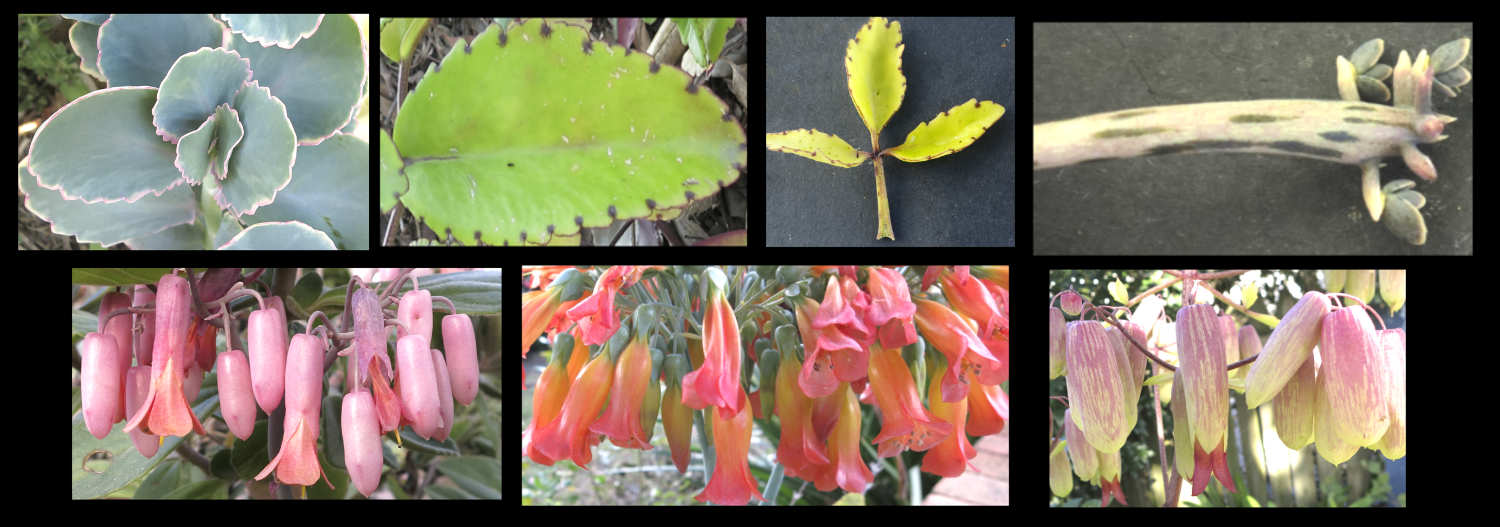Bryophyllum.
Bryophyllum was originally a separate genus in the Crassulaceae family.
They are now often seen as Kalanchoe species in the subfamily Kalanchoideae.
World Flora Online and Plants of the World Online include them all in the Kalanchoe genus.
However in Australia, including Queensland they are still mostly known as Bryophyllum.
The Australian Virtual Herbarium, Plant Name Index and the Plant Census all have them as Bryophyllum
with synonyms including Kalanchoe and Cotyledon.
Depending on how they are classified the number of species varies from 5 to around 30.
Spelling of the species names varies slightly depending on whether they are labeled as Bryophyllum or
Kalanchoe e.g. Bryophyllum pinnatum or Kalanchoe pinnata.
I will treat Bryophyllum as a separate genus with the common naturalised species.
The Australian Plant census lists:
1. Bryophyllum beauverdii (Kalanchoe beauverdii) is doubtfully naturalised in Queensland.
2. Bryophyllum daigremontianum (Kalanchoe daigramontiana) is naturalised in Qld.
3. Bryophyllum delagoense (B. houghtonii, B. tubiflorum, B. tubiflorumnom, Kalanchoe delagoensis and K. tubiflora) is naturalised in Qld.
4. Bryophyllum fedtschenkoi (K. fedtschenko) is naturalised in Qld.
5. Bryophyllum houghtonii (K. houghtonii, Bryophyllum x houghtonii a hybrid of B. daigremontianum and
B. delagoense) is naturalised in Qld.
6. Bryophyllum miniatum (K. miniata) is doubtfully naturalised in Qld.
7. Bryophyllum pinnatum (B. calycinum, K. pinnata, Cotyledon pinnata) is naturalised in Qld.
8. Bryophyllum proliferum (K. prolifera) is naturalised in Qld.
The APNI lists Bryophyllum beauverdii, B. daigremontianum, B. delagoense, B. fedtschenkoi, B. pinnatum, B. proliferum and B. tubiflorum.
Bryophyllum daigremontianum is the Mother-of-thousands,
Bryophyllum delagoense is the Mother-of-millions,
Bryophyllum x houghtonii a hybrid of B. daigremontianum x B. delagoense is the Hybrid Mother-of-millions,
Bryophyllum fedtschenkoi is Lavender scallops and
Bryophyllum pinnatum is the Resurrection plant.
Native to Madagascar they are characterised by having plantlets on the leaves.
Most are weeds here but they are still commonly cultivated.
*************************************************
Bryophyllums are perennial fleshy herbaceous plants.
The mostly upright stems are from 25 cm to 2 m high.
Some stems bend to lie on the ground where they root and produce new plants.
This, and suckers from the base can result in dense clumps.
Stems may have many branches, few or none apart from the inflorescences.
Stems are mostly round in cross section, smooth or rough and leaf scars may be visible.
Often with a waxy coating they can be green, grey, reddish, pink or purple.
Leaves, with almost no petiole or one a few cms long are opposite and may appear whorled.
They can be simple or divided with 3 or 5 leaflets.
Simple leaves are 1 to 25 cm long by 0.5 to 15 cm wide.
They can be ovate, obovate, oblong or folded and the edges can have small teeth or lobes.
There are no hairs and colours range from green to yellowish-green with a coating.
There may be coloured blotches on one or both surfaces.
A defining feature of the genus is the presence of small bulbils or plantlets on the leaf edges
(or in the inflorescences) that fall off to produce new plants.
Dense terminal inflorescences, up to 80 cm high consist of many branches up to 7 cm long.
The pendulous tubular bisexual flowers are on pedicels from 4 to 25 mm long.
The sepals are mostly fused into an inflated tube with 4 lobes.
Lobes, from 4 to around 10 mm long have a pointed tip.
The calyx can be shades of green often with streaks or blotches in red, pink or purple.
The petals, up to 6 cm long are fused into a tube with a constriction above the ovary.
The 4 lobes have blunt or pointed tips.
Petals can be greenish or shades of red, pink, orange or yellow sometimes with coloured streaks.
The 8 stamens, in 2 whorls are inserted onto the lower half of the corolla tube.
They do not extend past the petals.
The superior ovary consists of 4 carpels that are mostly free of each other.
Each carpel has numerous ovules and a single style.
The nectaries at the base of each carpel are a few mms long.
Each fruit consists of 4 narrow follicles 1 to 1.5 cm long that are enclosed in the dead flower parts.
Each has numerous brown seeds 1 to 2 mm long.
J.F.


